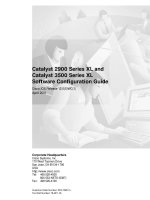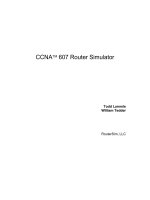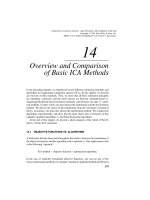H8-300H Series Overview, and H8-3048
Bạn đang xem bản rút gọn của tài liệu. Xem và tải ngay bản đầy đủ của tài liệu tại đây (344.98 KB, 9 trang )
h t t p : / / r e s o u r c e . r e n e s a s . c o m Page 20
Chapter 3
H8/300H Series Overview, and H8/3048
This chapter describes the use of an H8/3048 microcomputer from the
H8/300H family. The H8/3048 is a high-performance microcomputer having
ROM, RAM and peripheral functions.
It will help you understand the functions of this product.
3.1 H8/300H Series Product Map
The H8/300H series is a original high-performance, single-chip
microcomputer having a 16-bit CPU as its core together with peripheral
functions required for system configuration. Figure 3.1 shows the product
lineup of the H8 family.
Figure 3.1: Product Lineup of H8 Family
Figure 3.2 shows the product lineup of the H8/300H series.
h t t p : / / r e s o u r c e . r e n e s a s . c o m Page 21
Figure 3.2: Product Lineup of H8/300H series
3.2 H8/3048 Overview
In this course, an H8/3048 is used as the sample processor from the
H8/300H family. The H8/3048 includes the following three types: one having a
mask ROM or OTPROM as an internal ROM (simply referred to as the
H8/3048), an H8/3048F having an internal writable flash memory with two
power supplies (5V and 12V) and an H8/3048F-ONE having an internal
writable flash memory with a single power supply (5V). The only difference
among them is the type of internal ROM, the rest are almost the same.
Although this chapter describes the overview of the H8/3048F-ONE, the
descriptions in this and following chapters are common to all types. Note,
however, that the training board has been developed based on the H8/3048F-
ONE.
Figure 3.3 shows the H8/3048F-ONE internal block.
h t t p : / / r e s o u r c e . r e n e s a s . c o m Page 22
Figure 3.3: H8/3048F-ONE Internal Block
Features of CPU
- 16-bit CPU which serves as a general-purpose register machine.
Equipped with 16-bit × 16 general-purpose registers.
(Also available in 8-bit × 16 + 16-bit × 8 or 32-bit × 8 form.)
- High-speed CPU.
The maximum operating frequency of the H8/3048F-ONE is
25MHz and addition/subtraction can be executed in 80ns and
multiplication/division in 560ns.
The CPU is operated based on clock signals and the higher the
clock signal frequency, the faster the operation. The time of one
25MHz clock signal pulse is 0.04 microsecond (40ns), which is called
"1 state". Addition/subtraction are completed in two states and
multiplication/division in 14 states.
- Equipped with a maximum 16M bytes of address space.
(CPU, instructions and programs are described in Chapters 4, 5 and 6.)
Available both as single-chip and multi-chip microcomputer
It can be used as a single-chip microcomputer thanks to the internal
ROM, RAM and data I/O functions in addition to the CPU.
It can also be used as a multi-chip microcomputer when an external
memory is added due to insufficient ROM or RAM capacity. When used as a
multi-chip microcomputer, it has 24 address pins and up to 16M bytes of
memory can be added. Addresses consume 16M, 8 bits per address. Since there
are 16 data pins, 16 bits can be read or written simultaneously.
h t t p : / / r e s o u r c e . r e n e s a s . c o m Page 23
Internal ROM
It has a 128k byte, writable flash memory with a single 5V power
supply. This enables onboard writing.
For writing to the flash memory, a boot mode using a serial interface is
supported. Writing with a user-defined program is also available.
Internal RAM
It has an internal, 4k byte RAM.
I/O ports: 70 I/O pins and 8 input-only pins
The I/O ports can be used to input switch on/off statuses or signals from
various sensors. When used as output ports, they can control blinking of a
display lamp or turn a motor or heater on and off. The I/O ports are widely
used as general-purpose I/O functions.
On the training board, they are used to read switch statuses and control
LED displays.
Internal SCI (serial communication interface) × 2 channels
Channel 0 is available for a smart card interface.
For start-stop synchronization, it is used for RS-232C and other
communication functions. It is connected to a PC to enable data exchange.
On the training board, it is connected to a PC via RS-232C to send a
created program from a PC to the board or input a command for debugging.
Internal ITU (integrated timer unit) composed of 16-bit timer × 5 channels
Pulse outputs from up to 12 pins and up to 10 types of pulse inputs can
be processed.
It has a wide variety of uses such as measurement of time, speed and
frequency as well as control of pulse motors.
On the training board, a piezoelectric buzzer is provided so that pulses
can be heard as sounds.
Internal TPC (programmable timing pattern controller)
capable of outputting up to 16-bit pulses using the ITU as a time base
In combination with the ITU, a large number of pulse outputs are
available.
Internal watch-dog timer
Program runaway can be detected. Since control using a microcomputer
is based on programs, an extremely dangerous situation may occur if a program
should run away. This function is indispensable for creating a highly reliable
system.
Internal A/D converter with 10-bit resolution × 8 channels
The A/D converter is designed to input analog voltages instead of
digital voltages. For example, signals from a temperature sensor are input not
h t t p : / / r e s o u r c e . r e n e s a s . c o m Page 24
by high/low digital voltages but analog voltages. These signals are read after
being converted into 10-bit binary numbers.
On the training board, 0 to 5V analog voltages can be input with added
volume.
Internal 8-bit D/A converter × 2 channels
Unlike the A/D converter, the D/A converter is designed to output
analog voltages. It is also used to output desired waveforms or adjust volume
or hue of a TV.
On the training board, LEDs can be driven with D/A-converted output
voltages to control brightness.
Internal DMA controller × 4 channels (max.)
Used for high-speed data transfer. It enables data to be transferred faster
than with the CPU. It is generally used with a timer and other communication
functions.
Internal refresh controller
Refreshing is required to retain the data in the dynamic RAM. This
microprocessor has an internal controller for this purpose.
The H8/3048F-ONE can be used as a single-chip microcomputer. In
this form, no external memory can be added and only the internal one is
available. The operating mode when it is used as a single-chip microcomputer
is referred to as "single-chip mode". Figure 3.4 shows the memory map in
single-chip mode. In this mode, the memory addresses are expressed with 20
bits (5 digits in hexadecimal notation).
Figure 3.4: Memory Map in Single-chip Mode









